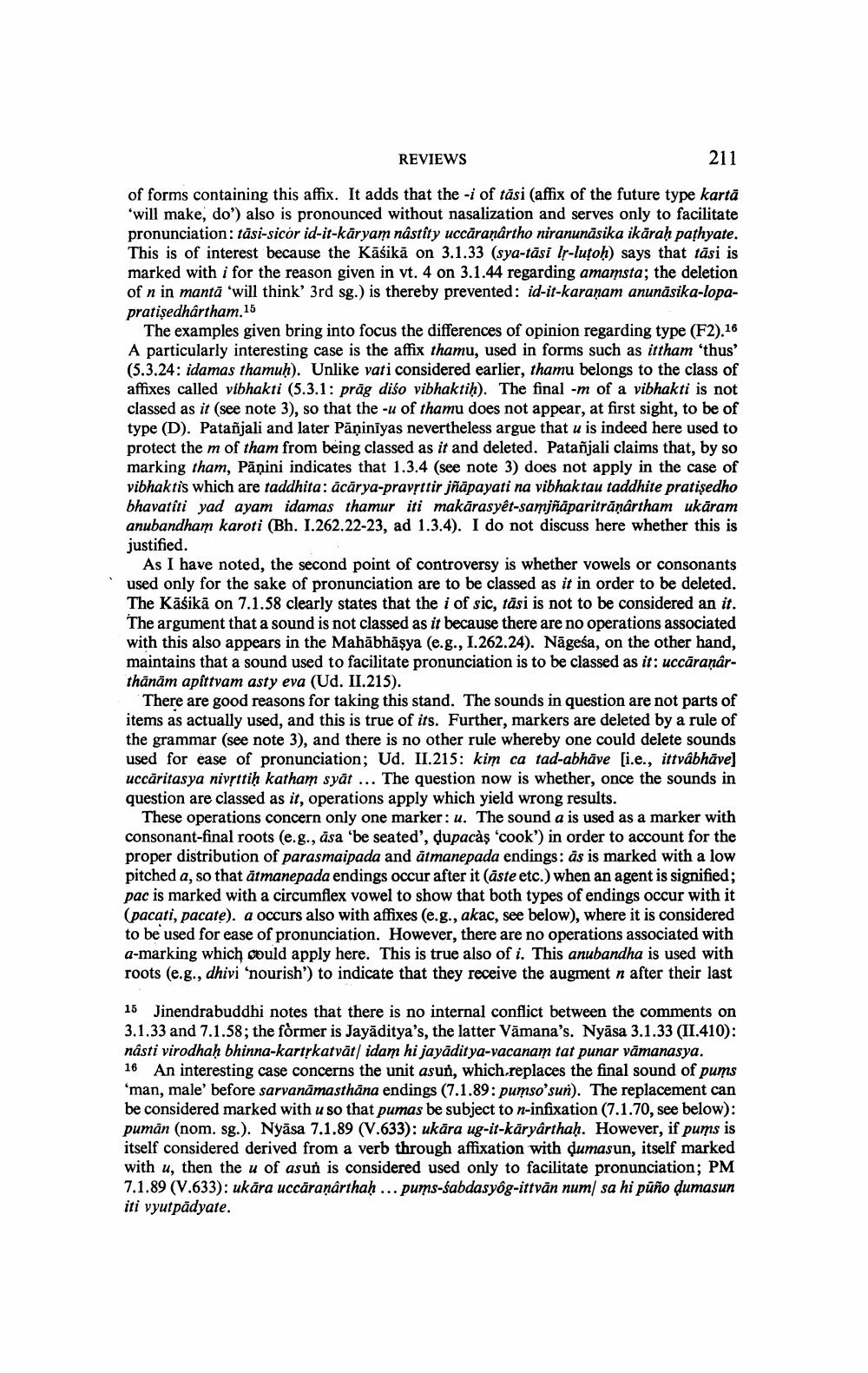Book Title: Reviews Of Different Books Author(s): Publisher: View full book textPage 5
________________ REVIEWS 211 of forms containing this affix. It adds that the -i of tasi (affix of the future type karta 'will make, do') also is pronounced without nasalization and serves only to facilitate pronunciation: tasi-sicor id-it-karyam nastity uccaranartho niranunasika ikarah pathyate. This is of interest because the Kasika on 3.1.33 (sya-tasi lr-lutoh) says that tasi is marked with i for the reason given in vt. 4 on 3.1.44 regarding amamsta; the deletion of n in manta 'will think' 3rd sg.) is thereby prevented: id-it-karanam anunasika-lopapratisedhartham,15 The examples given bring into focus the differences of opinion regarding type (F2).16 A particularly interesting case is the affix thamu, used in forms such as ittham 'thus' (5.3.24: idamas thamuh). Unlike vati considered earlier, thamu belongs to the class of affixes called vibhakti (5.3.1: prag diso vibhaktih). The final -m of a vibhakti is not classed as it (see note 3), so that the -u of thamu does not appear, at first sight, to be of type (D). Patanjali and later Paniniyas nevertheless argue that u is indeed here used to protect the m of tham from being classed as it and deleted. Patanjali claims that, by so marking tham, Panini indicates that 1.3.4 (see note 3) does not apply in the case of vibhaktis which are taddhita: acarya-pravsttir jnapayati na vibhaktau taddhite pratisedho bhavatiti yad ayam idamas thamur iti makarasyet-samjnaparitranartham ukaram anubandham karoti (Bh. 1.262.22-23, ad 1.3.4). I do not discuss here whether this is justified. As I have noted, the second point of controversy is whether vowels or consonants used only for the sake of pronunciation are to be classed as it in order to be deleted. The Kasika on 7.1.58 clearly states that the i of sic, tasi is not to be considered an it. The argument that a sound is not classed as it because there are no operations associated with this also appears in the Mahabhasya (e.g., 1.262.24). Nagesa, on the other hand, maintains that a sound used to facilitate pronunciation is to be classed as it: uccaranarthanam apittvam asty eva (Ud. II.215). There are good reasons for taking this stand. The sounds in question are not parts of items as actually used, and this is true of its. Further, markers are deleted by a rule of the grammar (see note 3), and there is no other rule whereby one could delete sounds used for ease of pronunciation; Ud. II.215: kim ca tad-abhave [i.e., ittvabhave] uccaritasya nivsttih katham syat ... The question now is whether, once the sounds in question are classed as it, operations apply which yield wrong results. These operations concern only one marker: u. The sound a is used as a marker with consonant-final roots (e.g., asa 'be seated', dupacas 'cook') in order to account for the proper distribution of parasmaipada and atmanepada endings: as is marked with a low pitched a, so that atmanepada endings occur after it (aste etc.) when an agent is signified; pac is marked with a circumflex vowel to show that both types of endings occur with it (pacati, pacate). a occurs also with affixes (e.g., akac, see below), where it is considered to be used for ease of pronunciation. However, there are no operations associated with a-marking which could apply here. This is true also of i. This anubandha is used with roots (e.g., dhivi 'nourish') to indicate that they receive the augment n after their last 15 Jinendrabuddhi notes that there is no internal conflict between the comments on 3.1.33 and 7.1.58; the former is Jayaditya's, the latter Vamana's. Nyasa 3.1.33 (II.410): nasti virodhah bhinna-kartykatvat/ idam hi jayaditya-vacanam tat punar vamanasya. 16 An interesting case concerns the unit asun, which replaces the final sound of pums 'man, male' before sarvanamasthana endings (7.1.89: pumso'sun). The replacement can be considered marked with u so that pumas be subject to n-infixation (7.1.70, see below): puman (nom. sg.). Nyasa 7.1.89 (V.633): ukara ug-it-karyarthah. However, if pums is itself considered derived from a verb through affixation with dumasun, itself marked with u, then the u of asun is considered used only to facilitate pronunciation; PM 7.1.89 (V.633): ukara uccaranarthah ... pums-sabdasyog-ittvan num/ sa hi puno dumasun iti vyut padyate.Page Navigation
1 ... 3 4 5 6 7 8 9 10 11 12 13 14 15 16 17 18 19 20 21 22 23 24 25 26 27 28 29 30 31 32 33
